MARIANI’S
Virtual
Gourmet
November
6, 2016
NEWSLETTER
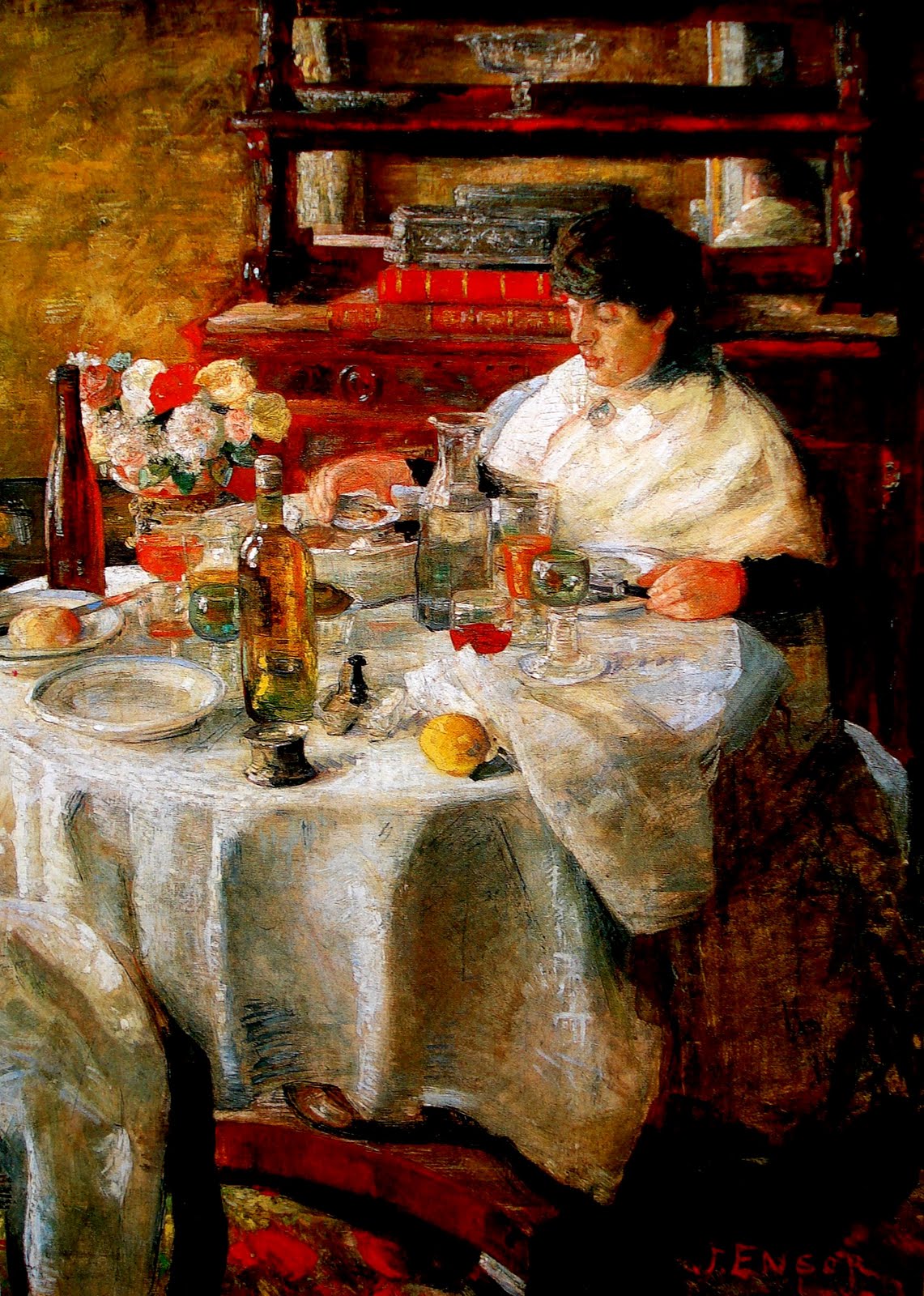
"The Oyster Eater" (1882) James Ensor
❖❖❖
IN THIS ISSUE
DINING AROUND WINSTON-SALEM, NC
By John Mariani
NEW YORK CORNER
BISTANGO
By John Mariani
NOTES FROM THE WINE CELLAR
GENTLY. . . IN TUSCANY
❖❖❖
DINING AROUND
WINSTON-SALEM, NC
By John Mariani

As I wrote of Winston-Salem last
week, the city is vibrant with the kind of
industries—bio-tech, high-tech, medicine, higher
education—that demand good restaurants of every
stripe, and on my recent visit there I found a
panoply of styles, from low to high. Plus, it’s
the home of Krispy Kreme Donuts, which began there
in 1937. Here
are places I wouldn’t want to miss.
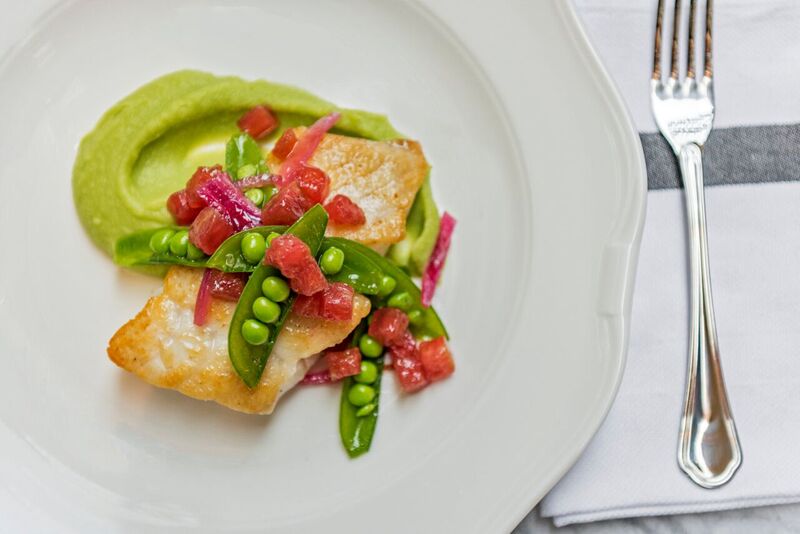 THE KATHARINE BRASSERIE &
BAR
THE KATHARINE BRASSERIE &
BAR
Kimpton Cardinal Hotel
4th & Main Street
336-761-0203
Located within what had been the
R.J. Reynolds headquarters building, with is
impressive art deco style, The Katharine, named
after Katharine Reynolds, is off the lobby of the
admirably modern Kimpton Cardinal Hotel, part of a
chain that wants to appeal to a Millennials crowd
with big rooms, big beds with Frette linens, an
evening wine hour, and in-room yoga mats. (Too bad
they offer free Wi-Fi only for their Karma Rewards
members.)
The Katharine styles itself as an
American brasserie with French connections and
Southern underpinning, via Executive Chef Ed Witt, who seems to have put as
much effort into his extensive tattoos as into his
cuisine. His
résumé is impressive, including jobs at Rubicon
and Jardinière in San Francisco, Daniel,
Il Buco and The River Café in NYC, and Morso in
Georgetown.
who seems to have put as
much effort into his extensive tattoos as into his
cuisine. His
résumé is impressive, including jobs at Rubicon
and Jardinière in San Francisco, Daniel,
Il Buco and The River Café in NYC, and Morso in
Georgetown.
The room, adjacent to the bar and with an open
kitchen, is well lighted and the roomy booths are
very comfortable, but the place can get exceedingly
loud since there are no soft surfaces.
One of the signature items here
is Witt’s presentation of snails and garlic butter
($12), baked inside hush puppies with maître d’hôtel
butter—as winning a marriage of French and Southern
cooking as I’ve ever run across. The same applies to
a French onion soup, here made with super-sweet
Vidalia onions topped with bubbling Lissome cheese
($10). A
nod to the North Atlantic is to be found in the
Tuesday special of hearty lobster pot pie ($34),
while on other days of the week country fried duck
breast, coq au vin or blanquette
of veal are featured.
 Of course,
there are platters of pristine shellfish ($75-$135),
and, when in season meaty Jonah crab claws ($6
each). An impeccably cooked grouper (above) was well
served on a bed of basil-laced light green mashed
potatoes with a charred tomato snap pea relish
($26). There
are four steak offerings, including an 8-ounce
bistro-style filet ($21) and a 14-ounce strip loin
($45), which, in the bistro spirit, you will want to
lavish with Béarnaise or bourbon peppercorn sauce (a
foie gras sauce is a $5 supplement).
Of course,
there are platters of pristine shellfish ($75-$135),
and, when in season meaty Jonah crab claws ($6
each). An impeccably cooked grouper (above) was well
served on a bed of basil-laced light green mashed
potatoes with a charred tomato snap pea relish
($26). There
are four steak offerings, including an 8-ounce
bistro-style filet ($21) and a 14-ounce strip loin
($45), which, in the bistro spirit, you will want to
lavish with Béarnaise or bourbon peppercorn sauce (a
foie gras sauce is a $5 supplement).
You won’t want to neglect the
sides, from the creamed corn spiked with jalapeño
($8) to
the blue cheese-lavished roasted mushrooms ($8);
string beans are glazed with sorghum and benne seeds
($8), yet another touch of culinary hands joined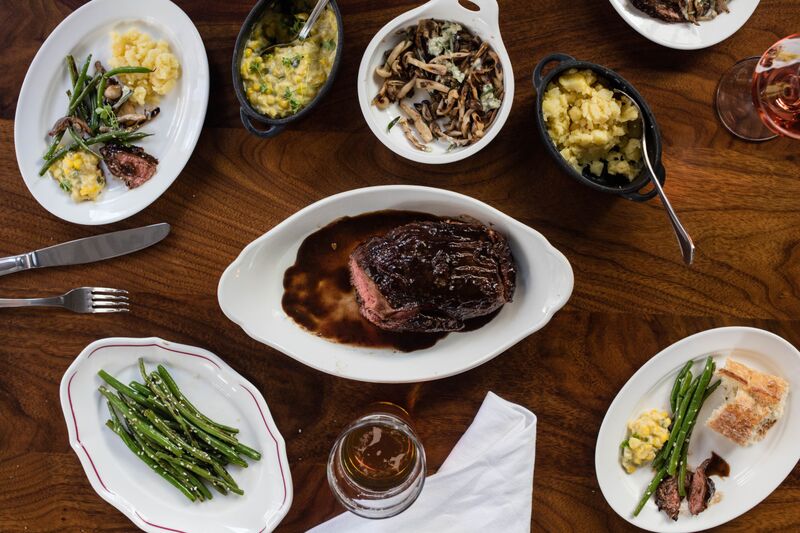 across the sea. A
vegetarian would be quite happy with just such
dishes.
across the sea. A
vegetarian would be quite happy with just such
dishes.
For
dessert you may want to consider the cookie plate
($8) with a walnut brownie, coconut macaroon, and
peanut butter cookies that any grown American child
will savor, though the French madeleines were
tasteless and limp when they should have been lemony
and crisp. A
honey pecan tart with salted caramel ice cream made
up for that lapse by being irresistible and not
overly sweet ($8).
House cocktails are $11, and the
wine list is unquestionably one of the best and best
selected in the state, with a large portion devoted
to French bottlings, including a good number from
Alsace, you don't often see on a restaurant menu.
Mark-ups are all over the map, with some bottles
hiked about 100%, but $300 for Château Batailley
Cinquième Grand Cru 2005 is more like 400% and a
bottle of Cakebread Chardonnay that sells for $36 in
a wine shop here goes for $115. There is also
a fine, extensive beer list.
Open for
breakfast and dinner daily; lunch Mon.-Fri.;
Brunch Sat. & Sun.
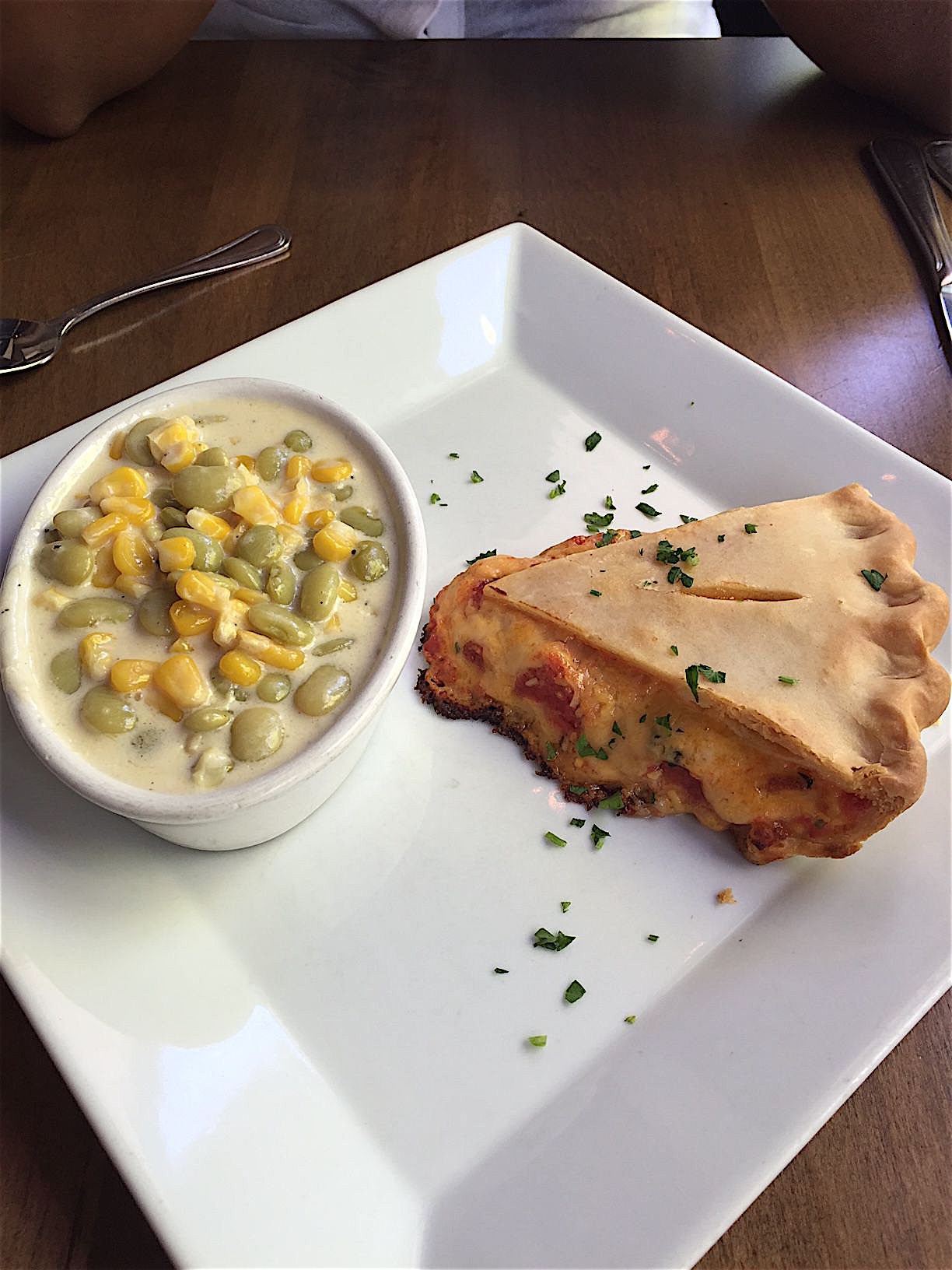 MOZELLE’S FRESH
SOUTHERN BISTRO
MOZELLE’S FRESH
SOUTHERN BISTRO
878
West 4th
Street
336-703-5400
Why owner Jennifer Smith
should bother to add the word “Fresh” to her
restaurant’s name is beyond me, for one bite of just
about anything on Chef Matt Haithcock’s menu at
Mozelle’s will tell you that they are buying the
best ingredients they can and making everything from
scratch. The
food is beautifully plated, care is taken with
texture and temperature, and the eclecticism of the
menu works in the restaurant’s favor as a casual but
smart place, bright with colors of orange and
avocado green against creamy walls and a congenial
counter bar.
This is a place where you’ll get
excellent fried chicken, which is fried boneless,
with peach, chutney, Mac-and-cheese and green
beans—$19, quite a bargain at dinner, $11 as a hefty
sandwich at lunch. There’s also good prole food like
the “Gourmet Meatloaf” ($19),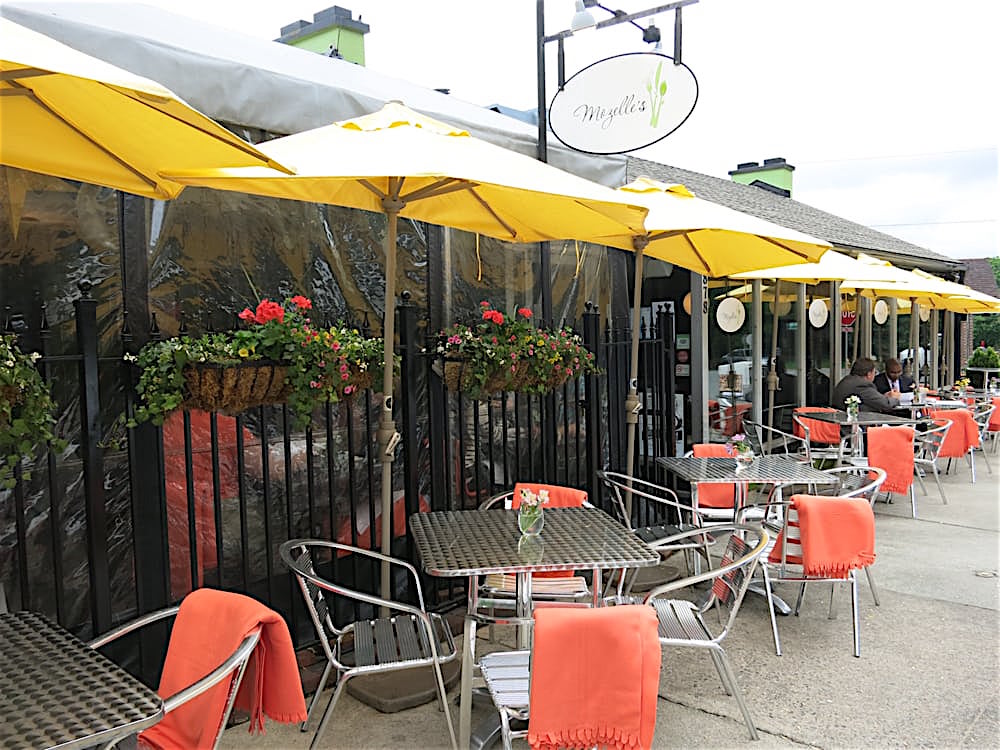 bacon
wrapped with havarti cheese, tomato marmalade, spicy
collard greens and cheese grits, which proudly
epitomize contemporary Piedmont cookery. Even more
to the point is the marvelous tomato pie ($17),
which is almost like a pizza within an American
short crust, served with cheese-rich stone ground
grits and lima beans (above).
bacon
wrapped with havarti cheese, tomato marmalade, spicy
collard greens and cheese grits, which proudly
epitomize contemporary Piedmont cookery. Even more
to the point is the marvelous tomato pie ($17),
which is almost like a pizza within an American
short crust, served with cheese-rich stone ground
grits and lima beans (above).
The Southern spring rolls ($11)
might have come out of a good Vietnamese kitchen,
here packed with pulled pork, shiitake mushrooms,
Napa cabbage, collards and a nutty sesame ginger
sauce, and you’ll see just how cannily Haithcock can
play with Southern tradition when you taste his
black-eyed pea fritters ($9) with bitter collard
green pesto, crisp bacon, and an assertive sambal aïoli
made with chive oil.
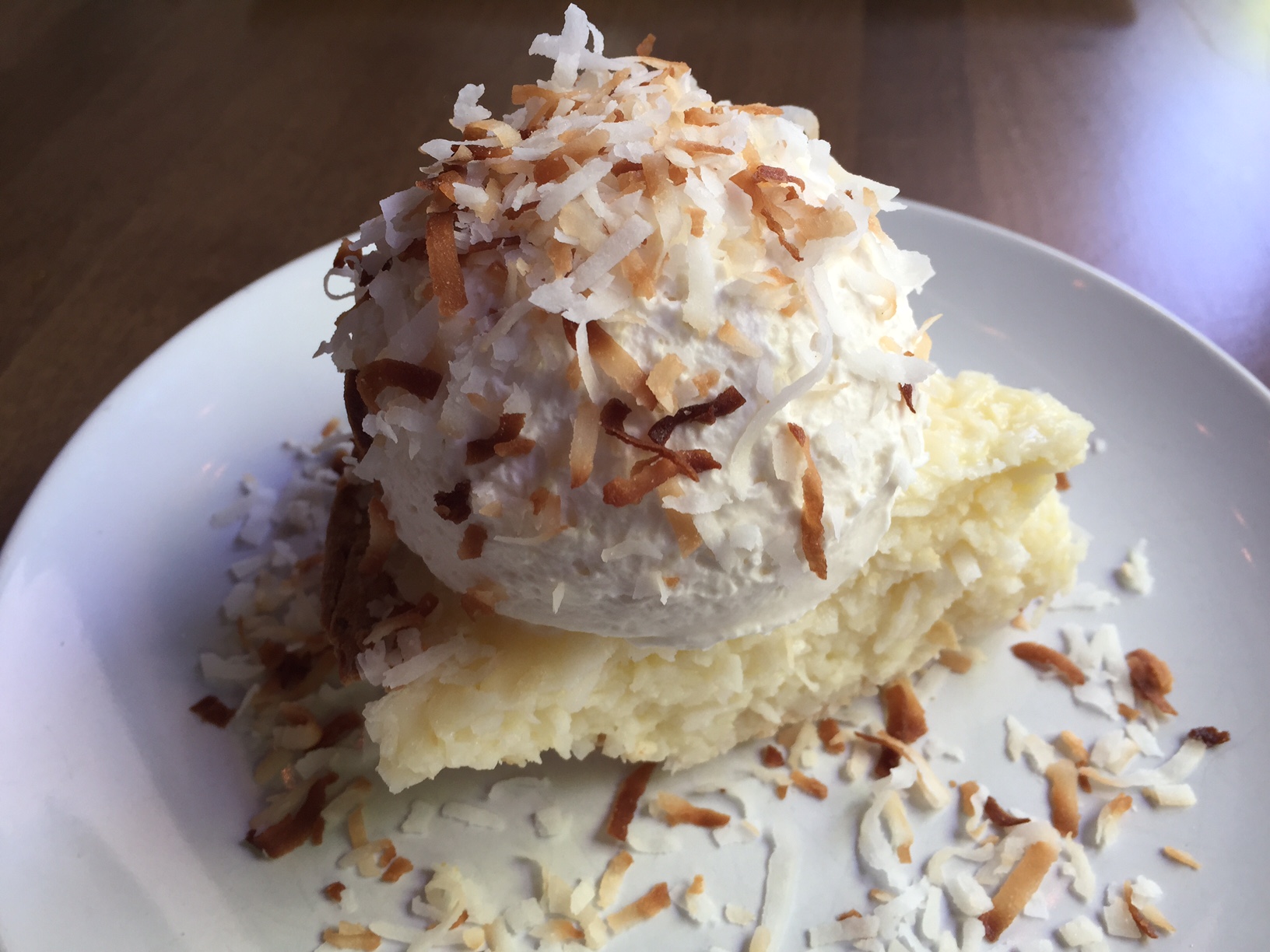 Desserts
revert to the American larder with bourbon pecan
bread pudding oozing caramel sauce ($7) and a
coconut cream pie ($7) that could have come straight
from the most modern edition of The Joy of
Cooking.
Desserts
revert to the American larder with bourbon pecan
bread pudding oozing caramel sauce ($7) and a
coconut cream pie ($7) that could have come straight
from the most modern edition of The Joy of
Cooking.
It is difficult to imagine anyone
wouldn’t enjoy dining on a sunny day at
Mozelle’s—the service staff itself will lift your
spirits—and it’s a fine indication of how very close
Winston-Salem is to the culinary scene of much
larger cities.
Open for lunch
Mon.-Fri., for brunch Sat & Sun., for dinner
nightly.
SPRING HOUSE
RESTAURANT, KITCHEN & BAR
336-293-4797
Located in the historic 1920s
Bahnson House on “Millionaire’s Row” and once used
as the city’s public library, Spring House enters
its fifth year as one of Winston-Salem’s fine dining
restaurants wholly free of pomp while remaining
genteel in the most disarming sense. Owners
Lynn Murphy and his wife, Lynette
Matthews-Murphy, have infused a congenial
hospitality in every detail and corner, including
the beautiful Library Bar, the sun room, and, in
good weather, tables outside on the spacious lawn. The place
retains the look of a great house with broad
staircases, French doors and fireplaces, white oak
floors, and four upstairs bedrooms. Inside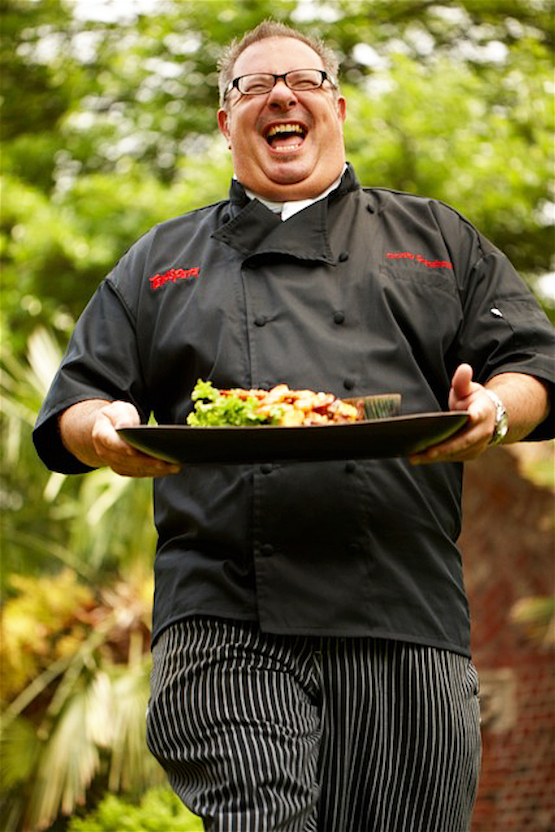 the kitchen
there is a “Chef’s Table” where chef/co-owner Tim
Grandinetti (left)
displays his considerable showmanship in lavish
multi-course dinners.
the kitchen
there is a “Chef’s Table” where chef/co-owner Tim
Grandinetti (left)
displays his considerable showmanship in lavish
multi-course dinners.
Otherwise the regular menu is long and has
something for everyone, each dish piled high with
food and garnishes, from the house salad towering
with juicy roast duck, caramelized onions,
mushrooms, potato and goat’s cheese ($25), to the
shrimp, crab, and roasted corn beignets with a red
beet sauce and horseradish condiment ($11.95). A dish
called “The Colonel” is composed of crispy
buttermilk fried chicken and “sawmill gravy” with
smoked tomato and pimento cheese grits ($19.95),
while the crusted pork chop ($23.95) comes with
brown sugar whipped sweet potatoes, pickled shrimp
and crab salad with smoked tomato rémoulade.
Chef Grandinetti is a generous and jolly fellow, and
no one leaves Mozelle's hungry or unhappy.
Open Mon.-Sat. for
dinner
THE TAVERN IN
OLD SALEM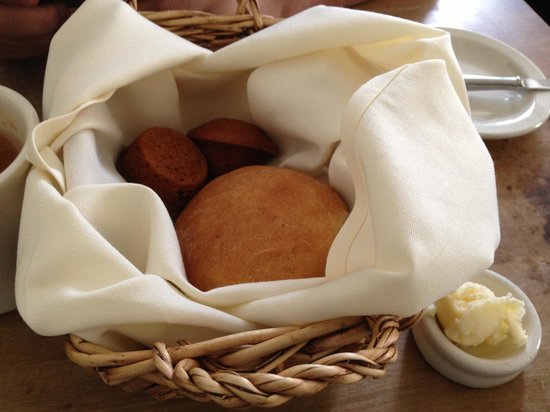
336-722-1227
It really is requisite for anyone
visiting Old Salem to eat at this utterly charming, butter
yellow 1784 tavern that will give you both an
historic sense and a true taste of what Moravian
food culture was like. Of course, this being a big
tourist destination, half its menu is composed of
sandwiches and burgers of a kind no Moravian ever
cooked, but if you stick to the front of the menu,
you’ll eat heartily and well, starting off with
impossible-to-resist snowflake biscuits and pumpkin
muffins served with warm apple butter ($2.75). A goat’s
cheese salad manifests Moravian abundance with
griddled pears, candied pecans, cranberries, zesty
red onions, sweet tomatoes and a white peach
vinaigrette ($8), all served by a staff in period
costume, who, fortunately, do not try to mimic a
Moravian accent.
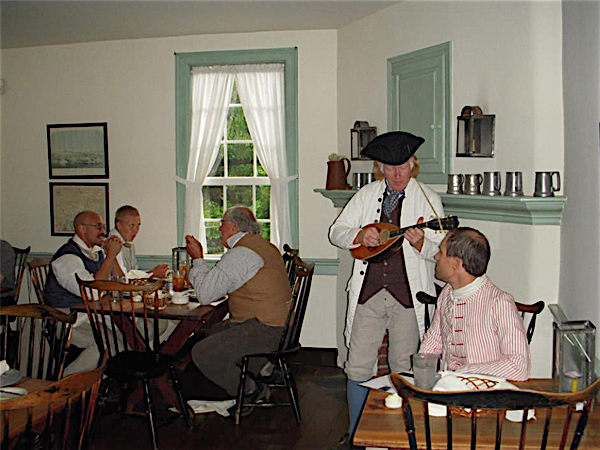 All the main
courses I tried were delicious: Chef Jared Keiper
boils bratwurst in beer then grills it and serves it
with house-made sauerkraut, green beans and
demi-glace ($9.75); the tavern chicken pie is quite
literally a large slice of pie pumped up with
abundant chunks of chicken and a rich creamy sauce
suffused with the flavors of herbs and spices,
served with Redskin mashed potatoes and green beans
($9.50); braised Angus beef pot roast comes with
those same potatoes and beans and the beef is slowly
cooked and swims in a brown ale gravy till it almost
falls apart ($10.50).
All the main
courses I tried were delicious: Chef Jared Keiper
boils bratwurst in beer then grills it and serves it
with house-made sauerkraut, green beans and
demi-glace ($9.75); the tavern chicken pie is quite
literally a large slice of pie pumped up with
abundant chunks of chicken and a rich creamy sauce
suffused with the flavors of herbs and spices,
served with Redskin mashed potatoes and green beans
($9.50); braised Angus beef pot roast comes with
those same potatoes and beans and the beef is slowly
cooked and swims in a brown ale gravy till it almost
falls apart ($10.50).
For dessert go with a very simple,
traditional chess pie that is not as sweet as they
too often are.
The wine list is adequate to the
menu and very decently priced, too.
MARY’S GOURMET
DINER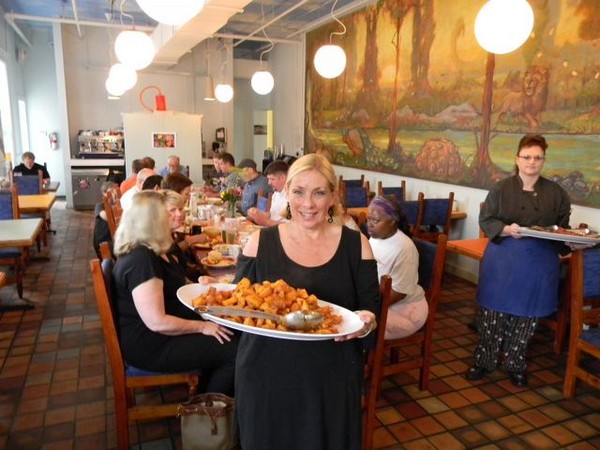
723
Trade Street
336-723-7239
There’s not a little
whimsy in attaching “Gourmet” to Mary’s Diner, now
six years in business, for while all the traditional
no frills chairs and tables and the
“sit-down-and-eat” ambiance are what you might
expect, they are enhanced beyond anything you might
imagine by vast murals by local artists of justified
reputation, including
Liz Simmons, Laura Lashley (below), Daniel VonSeggen, Jason
Blevins and John Blackburn. On one
wall is stretched the “Garden of Eden.” On another
“Culinary Warrior Women.” Stars twinkle, colors pop,
dinosaurs stroll with lions, and wit abounds.
 Mary’s began
on a smaller scale but business bloomed so well that
they were forced to get bigger and offer even
better. Breakfast is served six days a week, out of
an old bank building in the burgeoning Arts
District.
Mary’s began
on a smaller scale but business bloomed so well that
they were forced to get bigger and offer even
better. Breakfast is served six days a week, out of
an old bank building in the burgeoning Arts
District.
The Mary in question is Mary
Haglund, and nothing goes in or out of that kitchen
that she doesn’t deem the best she can buy and
serve, and do it at very reasonable prices: a square
deal for a square meal.
“Over the years,
many people have found it hard to believe the food
isn’t rigged with some ‘special’ ingredient,” she
says, “Perhaps it’s the LACK of strange ingredients
that blows people’s minds and taste buds.” Whatever
it is, I was enchanted with the place and the food,
from the billowy “build your own” omelets to the
plump breakfast burrito ($10.75) and the
griddle-fried cornmeal cakes with thick-sliced bacon
or sausage ($10.50). 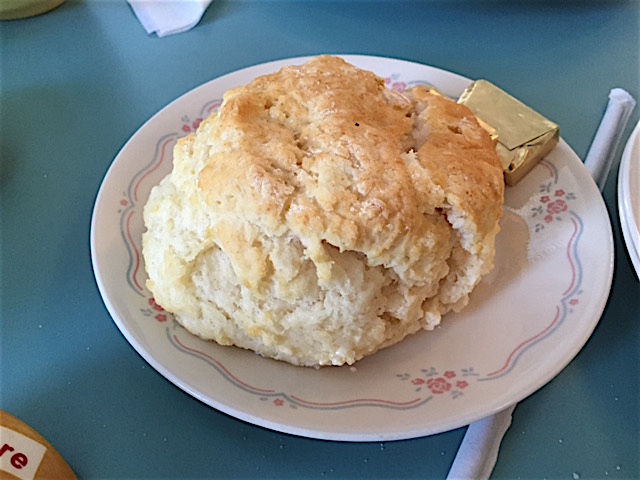 The
"cat's head biscuits" (right) at Mary’s are
knock-outs—big as a baseball, fluffy, buttery,
they’re light and airy but with just the right
textural heft and that tangy hint of buttermilk. Pour on
some pork gravy and you have a breakfast as good as
any in the South ($10.50), and one to hold you till
dinner. The
grits, as you can guess, are simply cooked but taste
of corn, topped with seasonal greens, tomatoes, two
fried eggs and feta ($10.95).
The
"cat's head biscuits" (right) at Mary’s are
knock-outs—big as a baseball, fluffy, buttery,
they’re light and airy but with just the right
textural heft and that tangy hint of buttermilk. Pour on
some pork gravy and you have a breakfast as good as
any in the South ($10.50), and one to hold you till
dinner. The
grits, as you can guess, are simply cooked but taste
of corn, topped with seasonal greens, tomatoes, two
fried eggs and feta ($10.95).
Down the
bottom of the long menu Mary lists her purveyors,
all from North Carolina, like Homeland Creamery
Dairy Products from Julian, Ward’s Happy
Chicken Eggs from McLeansville, Sanford Milling
Company Flour in Henderson, Plum Granny Farm Produce
from Greensboro, King and Kranies Coffee from
Winston-Salem.
It would never occur to her to serve anything
else, and her loyal clientele know that.
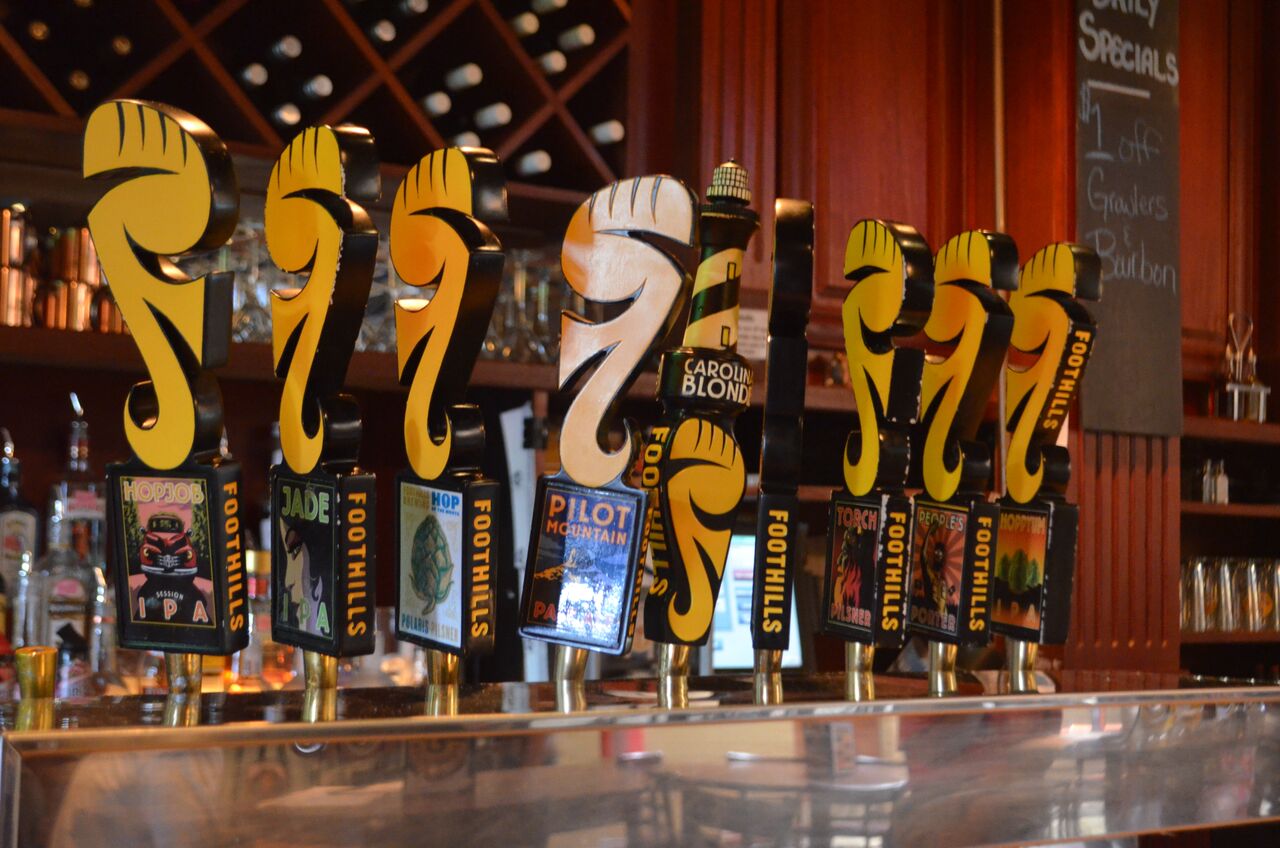
FOOTHILLS
DOWNTOWN PUB
638
West 4th Street
336-777-3348
You can’t get fresher beer
than at Foothills Downtown Pub (evoking the
Piedmont) because right there is where it’s
made—they give tours—and as a brew pub they are as
serious about their food as they are about their
beer. In
a big room flanked by the brewery and a good long
counter behind which stand expert bartenders who
pour dozens of their products with as much care as
an Italian barrista makes a cappuccino.
Each month Foothills features a
different special beer, which includes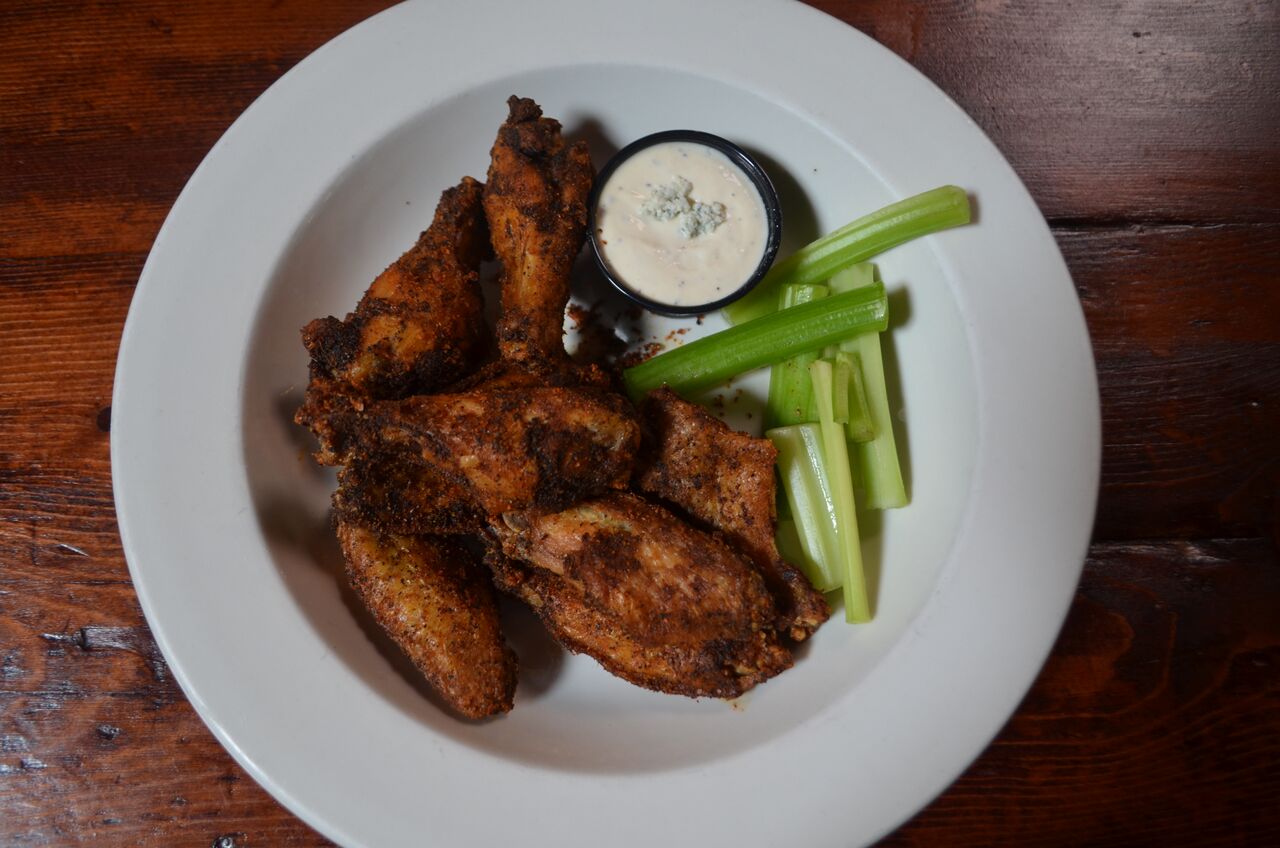 Sexual Chocolate in February, Hopjob
Session IPA in May, Oktoberfest in August and
Frostbite Black IPA in November. To go
with such plenty, you sit down to a big table, with
strangers if you care to, and chow down on fried
pickle chips with Ranch dressing ($5.99), loaded-up
Pub nachos ($8.99) with beer cheese, really
delicious wings (right)
with three sauces ($8.99) and larger platters of
pork ribs roasted in Carolina Cream Ale ($17.99).
The Reuben's slow-cooked (below) beef
is very moist on beautifully toasted rye, with
sauerkraut, Swiss cheese, and Thousand Island
dressing ($9.99). Bratwursts come with fresh
sauerkraut ($14.99), and burgers taste the way
burgers should—of first-rate, lightly compacted
ground beef, with a choice of sensible toppings,
which includes the Dirty South Burger with pimiento
cheese, bacon, tomato and fried pickles ($12.99).
Don’t forget the fat, crispy, greaseless onion ring
stack either ($5.99). With the prices here so
low, I guess they must make it up in beer
sales. Yeah, they do.
Sexual Chocolate in February, Hopjob
Session IPA in May, Oktoberfest in August and
Frostbite Black IPA in November. To go
with such plenty, you sit down to a big table, with
strangers if you care to, and chow down on fried
pickle chips with Ranch dressing ($5.99), loaded-up
Pub nachos ($8.99) with beer cheese, really
delicious wings (right)
with three sauces ($8.99) and larger platters of
pork ribs roasted in Carolina Cream Ale ($17.99).
The Reuben's slow-cooked (below) beef
is very moist on beautifully toasted rye, with
sauerkraut, Swiss cheese, and Thousand Island
dressing ($9.99). Bratwursts come with fresh
sauerkraut ($14.99), and burgers taste the way
burgers should—of first-rate, lightly compacted
ground beef, with a choice of sensible toppings,
which includes the Dirty South Burger with pimiento
cheese, bacon, tomato and fried pickles ($12.99).
Don’t forget the fat, crispy, greaseless onion ring
stack either ($5.99). With the prices here so
low, I guess they must make it up in beer
sales. Yeah, they do.
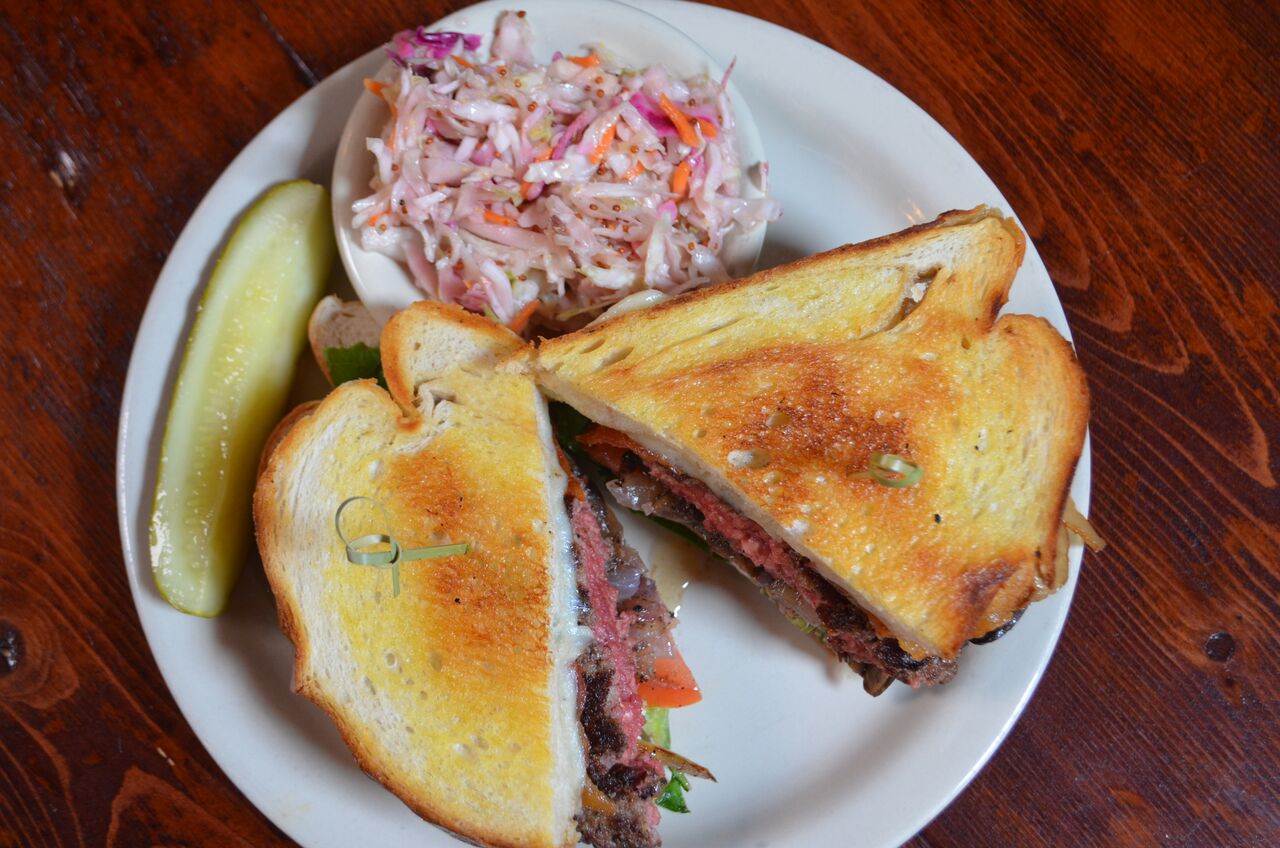 By any
stretch Foothills serves up damn good
food, and the beer adds a great deal more pleasure
to the reason you come here. I also
applaud the fact that in a state that mindlessly
allows citizens to carry guns into a bar, Foothills
posts a sign saying they don’t want you in there if
you’re packing heat.
Of course, they got some nasty letters and
boneheaded phone calls, but it’s the protesters’ loss for
missing out on food and beer this good.
By any
stretch Foothills serves up damn good
food, and the beer adds a great deal more pleasure
to the reason you come here. I also
applaud the fact that in a state that mindlessly
allows citizens to carry guns into a bar, Foothills
posts a sign saying they don’t want you in there if
you’re packing heat.
Of course, they got some nasty letters and
boneheaded phone calls, but it’s the protesters’ loss for
missing out on food and beer this good.
Open daily for lunch and dinner.
❖❖❖
By John Mariani
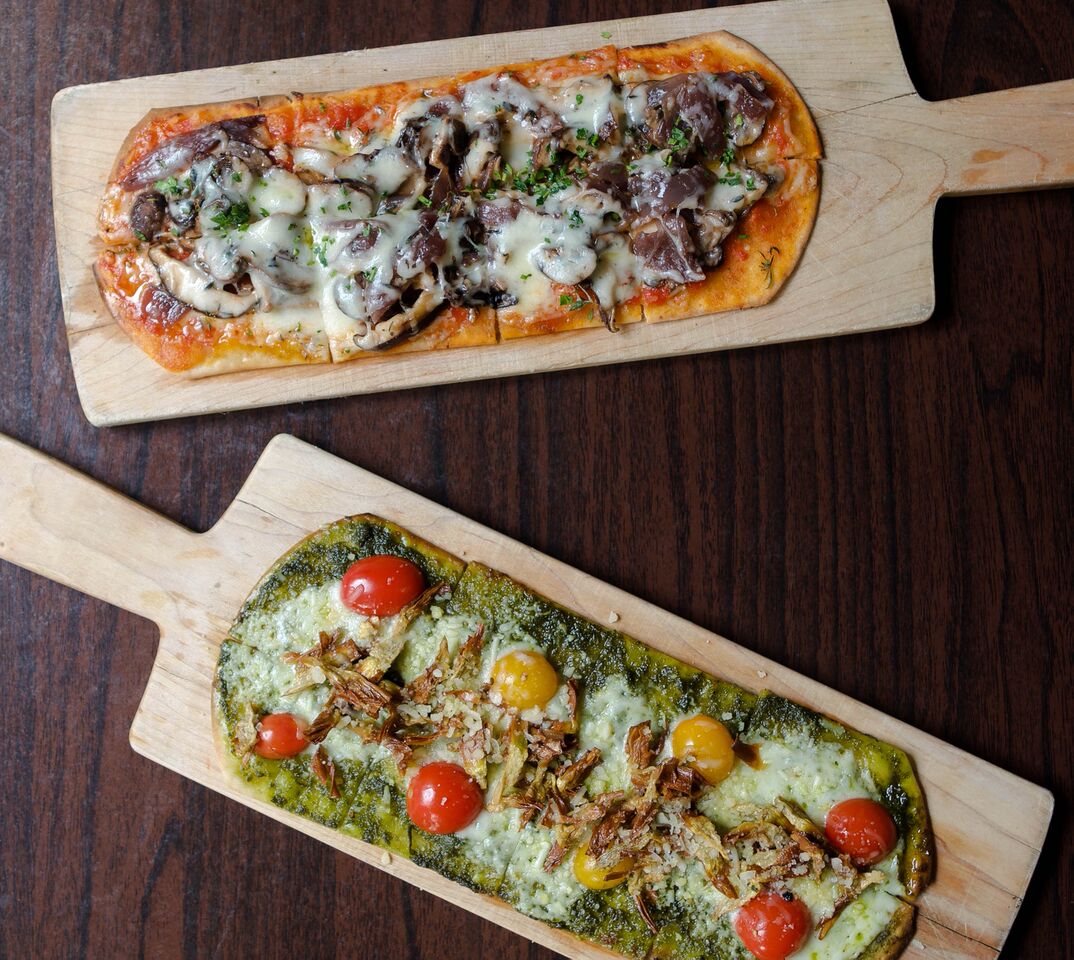 bistango
bistango
The Kimberly Hotel
145 East 50th Street (near Lexington Avenue)
212-888-4121
“Since 1988,
Bistango has been one of the best kept secrets
on Manhattan's East Side.” So
reads Bistango’s claim for its original
location on East 29th Street, and it has the
ring of truth as one of those neighborhood
spots that hasn’t had much media attention but
plays to a solid clientele of regulars.
A few months ago Bistango
branched out uptown to the Kimberly Hotel on
East 50th Street, and Chef Humberto Corona is
well on his way to building a similar base of
satisfied guests just now finding out about his
very good Italian food. Originally
from Puebla, Mexico, and self-taught as
a cook, he got his start in Italian cuisine ten
years ago at Bar Stuzzichini in the Flatiron
District, then was appointed Chef de Cuisine at
the Spanish tapas bar Ten Bells. He’s
a chef with a deft touch that makes so many
dishes so readily found elsewhere all his own.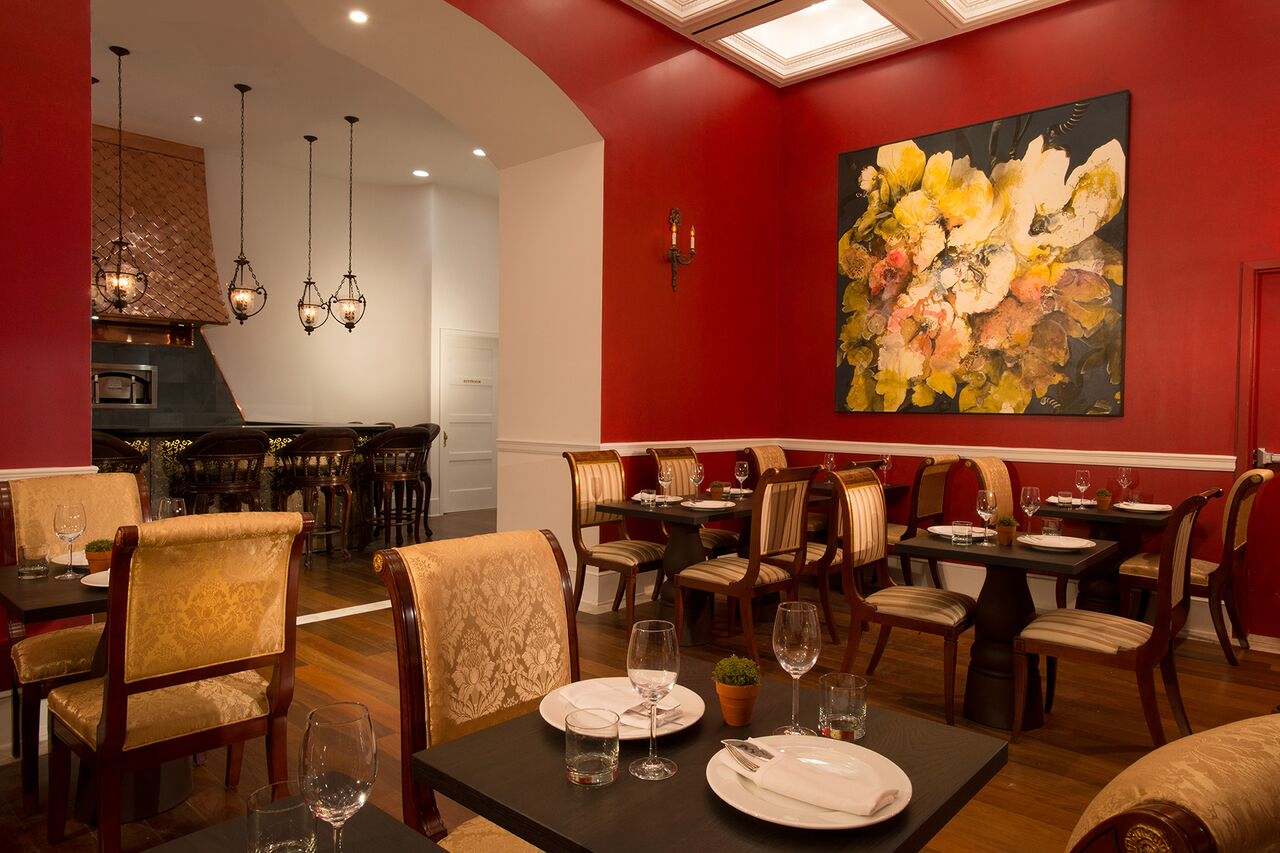
The dining room, headed by
the wholly affable manager, Erin Fisher, is an
oddly shaped spot past the lobby of the hotel,
with a pleasant bar counter to the rear. The
walls are a vibrant Carpaccio red, the splendid
artwork exploding in a profusion of flowers. Sturdy,
comfortable chairs are finely upholstered, but
the tables are unfortunately bare of
tablecloths, which doesn’t help the noise level
here. The
service staff is fast on their feet and need to
be, for the pacing of the food delivery from the
kitchen can lag even when the room is not full.
My
party of four people began with some admirable
creamy burrata
with prosciutto
and roasted sweet red peppers ($12); expertly grilled octopus was graced
with very fine olive oil and peppery greens
($16). Don’t
fail to order one or two of the flatbreads for
the table, which come steaming and crackly hot. We
enjoyed the Margherita with quickly cooked marinara, fresh
mozzarella, ricotta and leaves of basil ($14), and the Salsiccia, with hand-made sweet Italian
sausage and hot cherry peppers ($15)—both flatbreads quite
addictive. It would be hard to resist a
platter of the meatballs, once tasted (below).
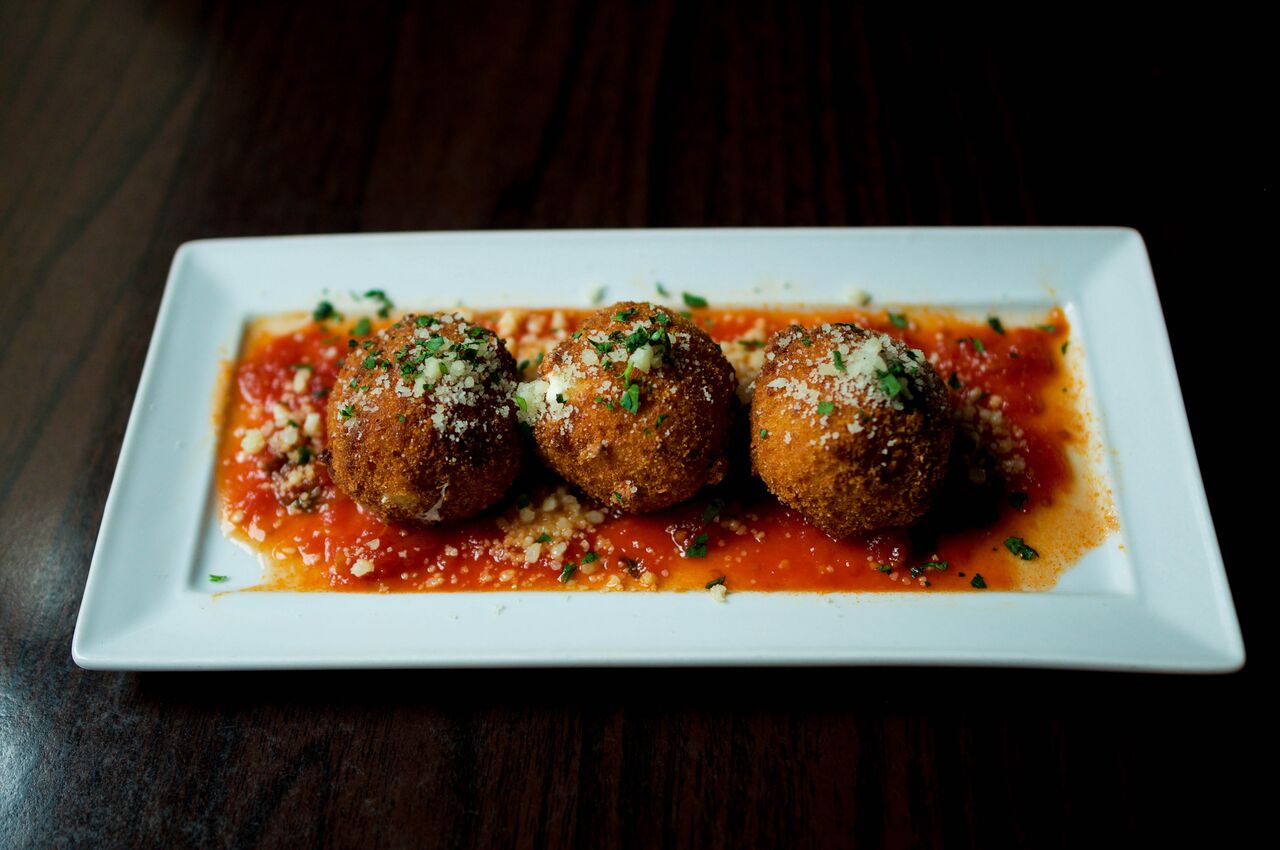 Pastas tried all had
the right heft of homemade dough, and portions
were very generous, so plan to share a plate of
tender fettuccine
with lobster,
cherry tomato and a touch of sherry ($25). Cavatelli
is one of my favorite pastas, best when slightly
chewy, here served with Italian sausage, kale
and a good dose of Calabrian chili to spark the
flavors up ($21). A lusty green sauce enhanced
the richness of short rib meat atop fat rigatoni
($22), and ravioli came plumply packed with
prosciutto in a wonderful hazelnut-studded pesto
and brown butter ($20).
Pastas tried all had
the right heft of homemade dough, and portions
were very generous, so plan to share a plate of
tender fettuccine
with lobster,
cherry tomato and a touch of sherry ($25). Cavatelli
is one of my favorite pastas, best when slightly
chewy, here served with Italian sausage, kale
and a good dose of Calabrian chili to spark the
flavors up ($21). A lusty green sauce enhanced
the richness of short rib meat atop fat rigatoni
($22), and ravioli came plumply packed with
prosciutto in a wonderful hazelnut-studded pesto
and brown butter ($20).
All around us it appeared
people were enjoying a large plate of eggplant
parmigiana ($20), highly recommended by our
waiter, and one bite showed why: everything
about this once humble dish was ennobled by
perfect ingredients and impeccable cooking, so
it did not fall or melt apart or show any
separation of the hearty sauce.
Veal alla
Milanese followed the line of big
proportions, topped with a radicchio,
Parmigiano, endive and cherry tomato mélange
($32), while a very good dry-aged ribeye came
with roasted Yukon potatoes, broiled herbed
tomato and olive oil ($38). Although
a nice piece of meat, a pork chop with white
beans ($32) was overcooked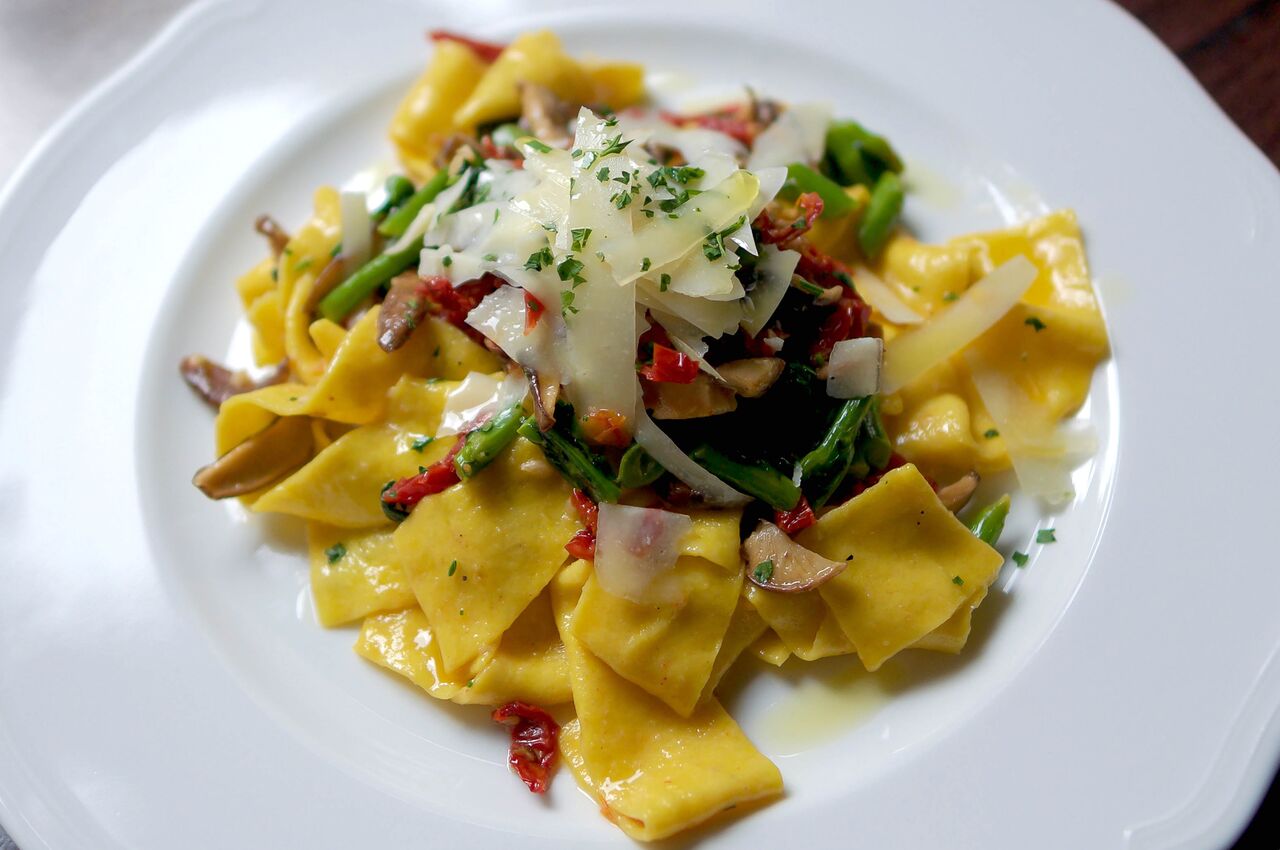 to
toughness.
to
toughness.
The desserts need an upgrade:
I wrote “OK” next to a White chocolate mousse
cake with roasted strawberries and rhubarb ($12)
and a mascarpone cheesecake with blackberry lime
salad ($12). The trendy olive oil cake ($12)
tasted like, well, cake suffused with olive oil,
which also ruined a lemon and caramel sundae
($10).
Bistango’s wine list could
easily be longer and better, but it serves well
enough, and mark-ups are not all that high.
This
new uptown Bistango is garnering local attention
and, I suspect, getting recommendations from
hotel concierges nearby because it is friendly,
reasonably priced and has the kind of Italian
food just about everyone loves. But
it also has a fine chef in Humberto Corona,
whose dedication to putting his own mark on a
meal is clearly evident.
Open daily from 11 a.m. to 11 p.m.;
Sunday Brunch.
Pre-theater
Prix Fixe $35.99
❖❖❖
GENTLY. . . IN TUSCANY

“I’m a contrarian,” insists Virginie
Saverys, which she says with the same
nonchalance she might use to say, “I’m
wearing a blue blouse.” When
you meet the woman, you see that her
declaration is self-evident.
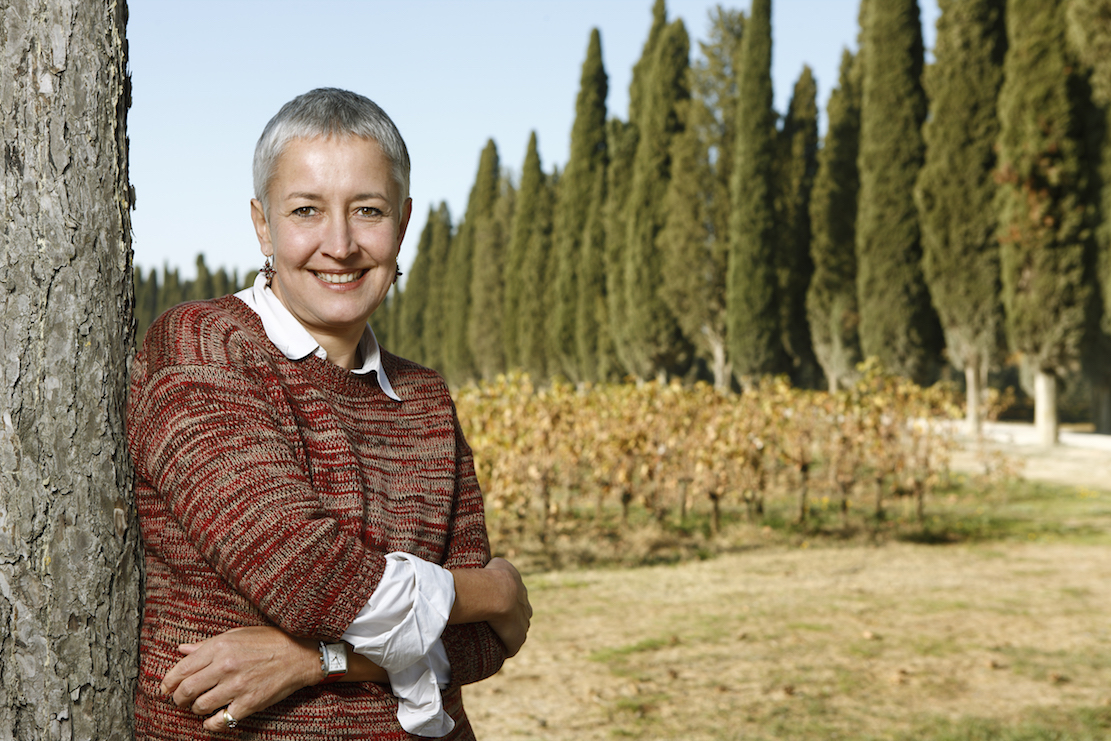 “When I
started to make waves in Tuscany,” where she
took over ownership of the 495-acre Avignonesi
vineyard in 2009,
“the old-timers thought of me as a rich
foreign woman poking her nose into their
traditions.
But, while they were importing more and
more foreign varietals and putting higher
percentages of them in their wines, I wanted my
traditional wines like Rosso di Montalcino and
Vino Nobile di Montepulciano to be made from
100% Sangiovese.” (Italian law allows up to 30%
other grapes to be added to the latter.)
“When I
started to make waves in Tuscany,” where she
took over ownership of the 495-acre Avignonesi
vineyard in 2009,
“the old-timers thought of me as a rich
foreign woman poking her nose into their
traditions.
But, while they were importing more and
more foreign varietals and putting higher
percentages of them in their wines, I wanted my
traditional wines like Rosso di Montalcino and
Vino Nobile di Montepulciano to be made from
100% Sangiovese.” (Italian law allows up to 30%
other grapes to be added to the latter.)
The fact was, Avignonesi’s
reputation had suffered for decades before
Ettore and Alberto Falvio, with winemaker Paolo
Trapolini, brought back much of the luster
before selling the winery to Saverys seven years
ago. Now, together with winemakers Matteo
Giustiniani and Australian Ashleigh Seymour, Saverys
is committed to becoming certified 100 percent
organic, following the concepts of biodynamics
through which, she says, “we must let the
vineyards imitate nature as far as possible,”
eschewing synthetic fertilizers and pesticides
she believes are harmful to a vineyard’s health.
Saverys also disdains the wholly unofficial term
“Super Tuscans,” which other wineries in the
region use to market their non-traditional,
highly priced bottlings.
An admitted “rich foreign
woman,” Saverys was born in Ghent, Belgium, the
daughter of a shipping magnate; she graduated
from law school in Paris and rose to the top
ranks of a prestigious law firm but then
resigned in 2006 because, “I didn’t want to be a
policeman; 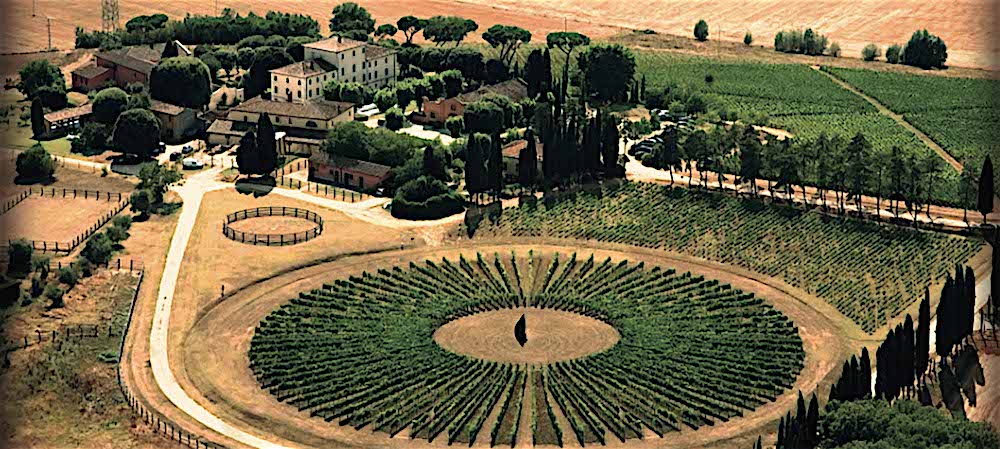 I prefer
deal making.”
I prefer
deal making.”
Her love
of Tuscany gave her the idea to buy Avignonesi,
which she has brought to a position of higher
respect than at any time in its existence since
1974, first for its quality and second for its
inclusionary hiring, with more than a hundred
different nationalities working at the winery.
Saverys is not likely to stop
being a contrarian if she believes doing so will
improve her wines, right down to experiments
with novel or controversial trellising systems
in different vineyards to take advantage of the
best exposure and to control density of the
vines. One
vineyard is even in the shape of a circle (right)
—this in a region where vines are famously grown
on rungs of hillsides.
 Ever
vigilant, Saverys is also concerned about
climate change.
Over dinner at Taralucci e Vino in New
York she said, “I never used to bring an
umbrella or a raincoat to Italy. Now
there’s so much rain and hail, both of which can
damage a vineyard.” Warming the planet can
benefit grapes by building up sugars in regions
like Bordeaux and Burgundy that don’t always get
ideal sun and heat. But in once sunny Tuscany,
Saverys doesn’t want to find those higher sugar
levels ferment into higher alcohol levels, and
she worries that her wines will reach above 15
percent alcohol.
Ever
vigilant, Saverys is also concerned about
climate change.
Over dinner at Taralucci e Vino in New
York she said, “I never used to bring an
umbrella or a raincoat to Italy. Now
there’s so much rain and hail, both of which can
damage a vineyard.” Warming the planet can
benefit grapes by building up sugars in regions
like Bordeaux and Burgundy that don’t always get
ideal sun and heat. But in once sunny Tuscany,
Saverys doesn’t want to find those higher sugar
levels ferment into higher alcohol levels, and
she worries that her wines will reach above 15
percent alcohol.
We began our dinner with
Italian sausages and cheeses with Avignonesi’s
Rosso di Montepulciano 2014 ($16)—an excellent
vintage—a lighter version of Vino Nobile, with a
delicate aroma and berry flavors, at 13%
alcohol. “I always serve this slightly chilled,”
she insisted, “it gives the wine a refreshing
quality.”
The winery’s flagship bottling, Vino
Nobile 2013 ($28), was a much richer, more
complex wine of 100% Sangiovese that spent 12
months in French barriques then six months in
much larger Slavonian casks, finally resting for
6 months in the bottle to allow the components
to knit. Still,
this is a wine that needs some time in the
bottle to soften the tannins; in two to three
years it will be superb. Typical
of the estate, they did not make a Grandi Annate
Vino Nobile in 2013 (they had in 2012, $88)
because the year was deemed not to be at the
highest level of quality.
Avignonesi does make a
non-traditional wine called Grifi ($58), which
lesser winemakers would likely call a Super
Tuscan; in fact, before Saverys bought the
estate, it was
called that.
Grifi is an IGT wine, meaning a wine
“typical of its geography” but not governed by
rules as to which grapes it must contain. Grifi
is a blend of Sangiovese and Cabernet Sauvignon, grown, respectively, in different
estates in Tuscany. Saverys poured the 2013
vintage first (57% Sangiovese, 43% Cab) because
she thinks the 2012, which we tasted,
still needs more time to mature, which makes
sense since there is 55% Cab with 45%
Sangiovese, providing more tannin, and because
the summer was hot and dry, giving the juice
more body.
The 2012 will be released next year. The
2013 was indeed farther along, more
medium-bodied and wonderfully ripe and perfumed
with spice.
Sauvignon, grown, respectively, in different
estates in Tuscany. Saverys poured the 2013
vintage first (57% Sangiovese, 43% Cab) because
she thinks the 2012, which we tasted,
still needs more time to mature, which makes
sense since there is 55% Cab with 45%
Sangiovese, providing more tannin, and because
the summer was hot and dry, giving the juice
more body.
The 2012 will be released next year. The
2013 was indeed farther along, more
medium-bodied and wonderfully ripe and perfumed
with spice.
One of
Avignonesi’s most interesting and unusual wines
is Desiderio 2012 ($58), another IGT made with
85% Merlot and 15% Cabernet Sauvignon. It
is, owing to the amount of Merlot, a very
velvety wine tasting of dry fruit, with a
structure of tannins that the Cab provides, with
14.5% alcohol, near the tipping point for
Avignonesi wines.
It’s a big, brawny wine with a soft
touch, named after a famously huge bull who
lived on the estate in the 19th century.
It went very well with a dish of pasta with duck
ragù.
Saverys wants to educate
people about her wines and the land, so visitors
can tour the property and have a fine lunch with
wines at the estate, or even take cooking
classes there.
The name Avignonesi
derives from Avignon in France, where the papacy
resided for six decades in the 14th century.
When the pope re-located to Rome, several noble
families of Avignon followed, with one branch
moving to Montepulciano in Tuscany. It's
a good bet Virginie Saverys will leave just as
indelible a footprint.
❖❖❖
OUR WACKY
CRIMINALS
 After breaking out of
jail, Shaun Higham (left) was arrested by the police
at Mitch’s Place in Paris, Arkansas, where he'd
wandered in for a beer. Higham told the owner to
call the police to say that, with his thirst now
satiated, he was more than happy to return to
prison. According to police, they
apprehended Higham without incident, finding him
“very cooperative and apologetic.” He was
brought back to
After breaking out of
jail, Shaun Higham (left) was arrested by the police
at Mitch’s Place in Paris, Arkansas, where he'd
wandered in for a beer. Higham told the owner to
call the police to say that, with his thirst now
satiated, he was more than happy to return to
prison. According to police, they
apprehended Higham without incident, finding him
“very cooperative and apologetic.” He was
brought back to prison
and charged with the original
aggravated-robbery charge, plus “numerous
additional charges.” . . . Meanwhile, in Arizona,
a fugitive pursued by local police pulled his car
into an In-N-Out burger
drive-through, but drove off and ditched his car
when service took too long. He then surrendered to
the police.
prison
and charged with the original
aggravated-robbery charge, plus “numerous
additional charges.” . . . Meanwhile, in Arizona,
a fugitive pursued by local police pulled his car
into an In-N-Out burger
drive-through, but drove off and ditched his car
when service took too long. He then surrendered to
the police.

HAVE YOU EVER CONSIDERED A LOBOTOMY?
"And
now
I am going to say something that you just need to
trust me on: Paging through Bacon’s cookbook was a
quasi-religious experience; I felt gleeful to the
point of borderline hallucination after reading
some lines. For instance, there is the sentence,
`Moon pots are the epitome of fancy lazy,' a
string of vaguely illogical words that lodged in
my brain the second I read it and refuses to let
go. (Moonpotsaretheepitomeoffancylazy!) There is
her desire, expressed earnestly and with a
slightly confused understanding of global
politics, `to be the one who gets to hug you as
you tell me you actually really like the taste of
unsweetened green juice, and that maybe world
peace really does start in the kitchen.'"--Gabriella Paiella, "Zen and the Art
of Reading the Moon
Juice Cookbook," NY Magazine
(10/24).
Any of John Mariani's books below may be ordered from amazon.com.
 The
Hound in Heaven (21st Century Lion Books)
is a novella, and for anyone who loves dogs,
Christmas, romance, inspiration, even the supernatural, I
hope you'll find this to be a treasured favorite.
The story concerns how, after a New England teacher,
his wife and their two daughters adopt a stray puppy found
in their barn in northern Maine, their lives seem full of
promise. But when tragedy strikes, their wonderful dog
Lazarus and the spirit of Christmas are the only things
that may bring his master back from the edge of
despair.
The
Hound in Heaven (21st Century Lion Books)
is a novella, and for anyone who loves dogs,
Christmas, romance, inspiration, even the supernatural, I
hope you'll find this to be a treasured favorite.
The story concerns how, after a New England teacher,
his wife and their two daughters adopt a stray puppy found
in their barn in northern Maine, their lives seem full of
promise. But when tragedy strikes, their wonderful dog
Lazarus and the spirit of Christmas are the only things
that may bring his master back from the edge of
despair. WATCH THE VIDEO!
“What a huge surprise turn this story took! I was completely stunned! I truly enjoyed this book and its message.” – Actress Ali MacGraw
“He had me at Page One. The amount of heart, human insight, soul searching, and deft literary strength that John Mariani pours into this airtight novella is vertigo-inducing. Perhaps ‘wow’ would be the best comment.” – James Dalessandro, author of Bohemian Heart and 1906.
“John Mariani’s Hound in Heaven starts with a well-painted portrayal of an American family, along with the requisite dog. A surprise event flips the action of the novel and captures us for a voyage leading to a hopeful and heart-warming message. A page turning, one sitting read, it’s the perfect antidote for the winter and promotion of holiday celebration.” – Ann Pearlman, author of The Christmas Cookie Club and A Gift for my Sister.
“John Mariani’s concise, achingly beautiful novella pulls a literary rabbit out of a hat – a mash-up of the cosmic and the intimate, the tragic and the heart-warming – a Christmas tale for all ages, and all faiths. Read it to your children, read it to yourself… but read it. Early and often. Highly recommended.” – Jay Bonansinga, New York Times bestselling author of Pinkerton’s War, The Sinking of The Eastland, and The Walking Dead: The Road To Woodbury.
“Amazing things happen when you open your heart to an animal. The Hound in Heaven delivers a powerful story of healing that is forged in the spiritual relationship between a man and his best friend. The book brings a message of hope that can enrich our images of family, love, and loss.” – Dr. Barbara Royal, author of The Royal Treatment.
 |
The Encyclopedia of American Food and Drink by John F. Mariani (Bloomsbury USA, $35) Modesty forbids me to praise my own new book, but let me proudly say that it is an extensive revision of the 4th edition that appeared more than a decade ago, before locavores, molecular cuisine, modernist cuisine, the Food Network and so much more, now included. Word origins have been completely updated, as have per capita consumption and production stats. Most important, for the first time since publication in the 1980s, the book includes more than 100 biographies of Americans who have changed the way we cook, eat and drink -- from Fannie Farmer and Julia Child to Robert Mondavi and Thomas Keller. "This book is amazing! It has entries for everything from `abalone' to `zwieback,' plus more than 500 recipes for classic American dishes and drinks."--Devra First, The Boston Globe. "Much needed in any kitchen library."--Bon Appetit. |
"Eating Italian will never be the same after reading John Mariani's entertaining and savory gastronomical history of the cuisine of Italy and how it won over appetites worldwide. . . . This book is such a tasteful narrative that it will literally make you hungry for Italian food and arouse your appetite for gastronomical history."--Don Oldenburg, USA Today. "Italian
restaurants--some good, some glitzy--far
outnumber their French rivals. Many of
these establishments are zestfully described
in How Italian Food Conquered the World, an
entertaining and fact-filled chronicle by
food-and-wine correspondent John F.
Mariani."--Aram Bakshian Jr., Wall Street
Journal.
"Equal parts
history, sociology, gastronomy, and just
plain fun, How Italian Food Conquered the
World tells the captivating and delicious
story of the (let's face it) everybody's
favorite cuisine with clarity, verve and
more than one surprise."--Colman Andrews,
editorial director of The Daily
Meal.com. "A fantastic and fascinating
read, covering everything from the influence
of Venice's spice trade to the impact of
Italian immigrants in America and the
evolution of alta cucina. This book will
serve as a terrific resource to anyone
interested in the real story of Italian
food."--Mary Ann Esposito, host of PBS-TV's
Ciao
Italia. "John Mariani has written the
definitive history of how Italians won their
way into our hearts, minds, and
stomachs. It's a story of pleasure over
pomp and taste over technique."--Danny Meyer,
owner of NYC restaurants Union Square
Cafe, The Modern, and Maialino.
|
 |
 |
 |
 |
 |
 |
 |
 |
 Everett Potter's Travel Report:
Everett Potter's Travel Report: 
 Eating Las Vegas
JOHN CURTAS has been covering the Las Vegas
food and restaurant scene since 1995. He is
the co-author of EATING LAS VEGAS – The 50
Essential Restaurants (the fourth
edition of which will be published in early
2016), as well as the author of the Eating Las
Vegas web site: www.eatinglasvegas.
He can also be seen every Friday morning as
the “resident foodie” for Wake Up With the
Wagners on KSNV TV (NBC) Channel 3 in
Las Vegas.
Eating Las Vegas
JOHN CURTAS has been covering the Las Vegas
food and restaurant scene since 1995. He is
the co-author of EATING LAS VEGAS – The 50
Essential Restaurants (the fourth
edition of which will be published in early
2016), as well as the author of the Eating Las
Vegas web site: www.eatinglasvegas.
He can also be seen every Friday morning as
the “resident foodie” for Wake Up With the
Wagners on KSNV TV (NBC) Channel 3 in
Las Vegas.

MARIANI'S VIRTUAL GOURMET
NEWSLETTER is published weekly. Editor/Publisher: John
Mariani.
Editor: Walter Bagley. Contributing Writers: Christopher Mariani,
Robert Mariani, Misha
Mariani,
John A. Curtas, Edward Brivio, Mort Hochstein,
Andrew Chalk, Dotty Griffith and Brian Freedman. Contributing
Photographers: Galina Dargery, Bobby
Pirillo. Technical Advisor: Gerry McLoughlin.
To un-subscribe from this newsletter,click here.
© copyright John Mariani 2016

